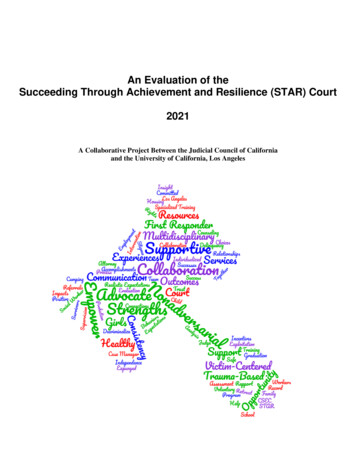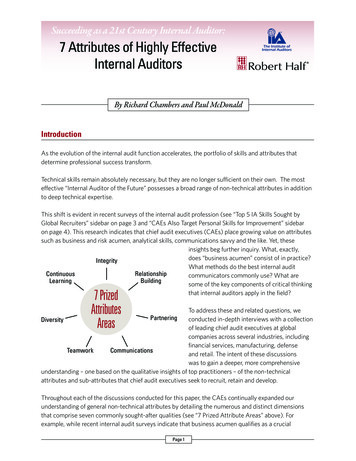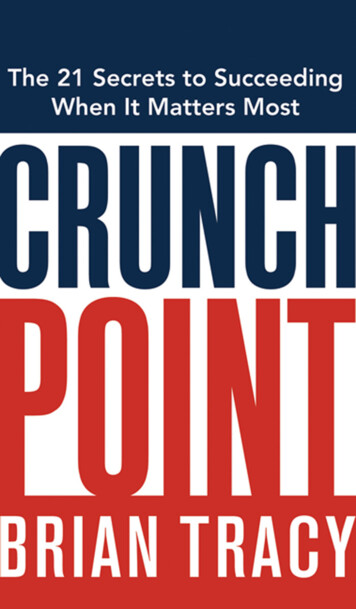
Transcription
An Evaluation of theSucceeding Through Achievement and Resilience (STAR) Court2021A Collaborative Project Between the Judicial Council of Californiaand the University of California, Los Angeles
Judicial Council of CaliforniaOperations and Programs DivisionCenter for Families, Children & the Courts455 Golden Gate AvenueSan Francisco, California 94102-3688cfcc@jud.ca.govwww.courts.ca.govPrepared by the Center for Families, Children & the CourtsCopyright 2021 by Judicial Council of California.All rights reserved.Except as permitted under the Copyright Act of 1976, no part of this publication may be reproduced inany form or by any means, electronic, online, or mechanical, including the use of information storageand retrieval systems, without permission in writing from the copyright owner. Permission is grantedto nonprofit institutions to reproduce and distribute for educational purposes all or part of the work ifthe copies are distributed at or below cost and if the Judicial Council of California, Center for Families,Children & the Courts are credited.For additional copies, please call the Center for Families, Children & the Courts at 415-865-7739 orwrite to the Judicial Council of California at the address above.All Judicial Council briefings and reports are available on the California Courts website atwww.courts.ca.gov/cfcc-publications.htm.Printed on recycled and recyclable paper
Judicial Council of CaliforniaChief Justice Tani G. Cantil-SakauyeChair of the Judicial CouncilMartin HoshinoAdministrative DirectorRobert OyungOperations and Programs Division Chief Operating OfficerCenter for Families, Children & the CourtsCharlene Depner, PhDDirectorDon WillAssistant DirectorCassandra McTaggartPrincipal ManagerCarrie ZollerSupervising AttorneyAmy J. Bacharach, PhDSenior Research Analyst, AuthorDonna StrobelAnalyst, AuthorSemel Institute for Neuroscience and Human Behavior at University of California, Los AngelesEraka Bath, MDDirector, Child Forensic Services, and Associate Professor, Department of Psychiatry, AuthorSarah GodoyResearch Associate (now with University of North Carolina at Chapel Hill), AuthorMariam NazinyanResearch Associate, AuthorGeorgia PerrisProgram Manager, Author
AcknowledgementsThe researchers are grateful for the time and effort of everyone involved with the STAR Court,including Judge Catherine J. Pratt; Michelle Guymon, director of the Child Trafficking Unit of the LosAngeles County Probation Department; the probation officers, defense attorneys, prosecutors,advocates, and treatment providers dedicated to this court; all the members of the multidisciplinaryteam; and the survivor graduates who participated in this study.This research is partly funded by a Clinical and Translational Science Institute grant (CTSI GrantUL1TR001881) and by the National Institute on Drug Abuse and the National Institutes of Healthunder the AACAP NIDA K12 2016–2020 program (Grant # K12DA000357).
Table of ContentsIntroduction. 1About This Evaluation/Method . 3About STAR Court: Process Evaluation Results. 5Court Operations . 5Multidisciplinary Team . 6Eligibility and Referrals . 7Challenges. 7Model Practices of the STAR Court . 8Outcome Evaluation Results. 9Demographics . 10Court Participation . 11Education . 12General Health . 13Mental Health . 14Substance Use . 16Past Victimization . 17Child Welfare History. 18Housing Placement History . 19AWOL History . 20Bench Warrant History . 21Arrest History and Recidivism . 22Discussion/Summary of Findings . 24Conclusion . 27Methodological Index . 28“There should be a STAR Court in every court building there is.” STAR Court graduate
IntroductionThe Judicial Council’s Center for Families, Children & the Courts partnered with the University ofCalifornia, Los Angeles (UCLA), to conduct a comprehensive study of the Los Angeles SucceedingThrough Achievement and Resilience (STAR) Court. The STAR Court is a juvenile collaborative courtprogram focused on diverting commercially sexually exploited children (CSEC) or youth at risk ofexploitation from the traditional juvenile court and providing trauma-informed services by speciallytrained court staff.1 The STAR Court is one of 11 girls’ courts or CSEC courts in California and isnationally recognized as a model for working with youth in the juvenile justice system.2The court was created in 2012 in an effort to provide the same support and resources in the juvenilejustice system that youth victims in the child welfare system receive, as well as to build on thestrengths of youth who have experienced commercial sexual exploitation (CSE) and reconnect themwith healthy relationships and behaviors. This was in response to observations of poor outcomes foryouth experiencing CSE in the delinquency system.In Los Angeles, 85 percent of youth found in sex trafficking raids have a history with child protectiveservice.3 There are no estimates about how many girls in the juvenile justice system are traffickingvictims or at risk of sexual exploitation. However, girls account for approximately 30 percent ofjuvenile arrests annually. 4 Anecdotal data suggest that nearly all girls in the juvenile justice systemhave been sexually exploited at some point.In 2016, the California Governor signed Senate Bill (SB) 1322 to decriminalize prostitution for youthunder the age of 18 since they cannot consent to sex and are thus automatically considered to be acommercially sexually exploited child.5 Under SB 1322, victims of suspected child sex trafficking arereferred to the county child welfare department rather than arrested for a prostitution-related offense.Because victims are often arrested for offenses that are not prostitution-related, such as petty theft,selling drugs, or fighting, SB 1322 has not decreased the number of trafficking victims in the juvenilejustice system, however.This report details the results of a process and outcome evaluation of the STAR Court.For information on girls’ courts and CSEC courts, seewww.courts.ca.gov/documents/JCJC Models Girls and CSEC courts.pdf.1A.J. Bacharach & D. Strobel, An Overview of California’s Girls’ and CSEC Courts: Process Evaluation Report (2021).Retrieved from aluation-Report-FINAL2.pdf.23M. Ackerman-Brimberg, K. Walker Brown, & A. Newcombe, Los Angeles Law Enforcement First Responder Protocolfor Commercially Sexually Exploited Children, What We’ve Learned: A Four Year Look (2018). Retrieved -review-191104b.pdf.4C. Puzzanchera & S. Ehrmann, Spotlight on Girls in the Juvenile Justice System (2018). National Center for JuvenileJustice. Retrieved from -Juvenile-Justice-System.aspx.5Stats. 2016, ch. 654.Introduction1
Review of the LiteratureDue to the relative novelty of girls’ courts in general, there has not been enough research to determinethe effectiveness of these courts. There have been only two studies published: Researchers of theHonolulu’s girls’ court, which is a general girls’ court not specific to CSEC, found positive results inreducing recidivism and running away and encouraged its replication.6 However, an evaluation of ahuman trafficking court docket in Ohio revealed high attrition rates and a failure to keep participantsfrom leaving “the life.”7 The authors of that study suggested that the court’s conflicting framework ofdefining participants as both victims and delinquents contributed to the court’s failures thus far. Thatcourt is also a mandated program versus the STAR Court, which, like most girls’ and CSEC courts, isvoluntary. Other girls’ courts and CSEC courts have reported informal, unpublished positive results.8Given the dearth of available research on the efficacy of these courts, this study seeks to fill a criticalgap in the literature.The first phase of the current evaluation provided descriptive data about STAR Court participants andexamined participants between the time they entered the program and the time they exited. Resultsshowed a reduction in the number of housing placements, as well as in the average number of daysspent in placement, between those times. In addition, recidivism, defined as rearrests in the juvenilejustice system, was reduced by about half, a statistically significant reduction.9 This report detailsresults of the subsequent phase using comparative analyses.Study ObjectivesThe main objectives of this evaluation were to (1) understand how the STAR Court operates anddescribe the court; (2) examine the outcomes of the STAR Court and describe the court’s impacts; and(3) gain insight into the experiences of participants of the court and those who work with these youth.Although the STAR Court is open to those of any gender, almost all participants have been cisgendergirls, and all cases included in this study are girls. Thus, this report will refer to participants as “she,”understanding that others may be participants.J. Davidson, L. Pasko, & M. Chesney-Lind, “‘She’s Way Too Good to Lose’: An Evaluation of Honolulu’s Girls Court”(2011) 21(4) Women & Criminal Justice, 308–327.6M. Luminais, R. Lovell, & M. McGuire, “A Safe Harbor Is Temporary Shelter, Not A Pathway Forward: How CourtMandated Sex Trafficking Intervention Fails to Help Girls Quit the Sex Trade” (2019) 14(5) Victims & Offenders, 540–560.78Bacharach & Strobel, supra, note 2.A.J. Bacharach, S. Godoy, D. Strobel, & E. Bath, “Research Update: STAR Court Study: Initial Results”(2020). Retrieved from ourt-study.pdf.9Introduction2
About This Evaluation/MethodThis study used a mixed-methods approach to conduct both a process and outcome evaluation. Theprocess evaluation examined how the court program works through a content analysis while theoutcome evaluation examined whether the program works through comparative analyses.Prior to the study, the researchers obtained a court order from the Superior Court of Los AngelesCounty, juvenile division, approving the study procedures and granting a limited waiver ofconfidentiality to review the case files and collect and analyze the data from those in STAR Court andthose in both comparison groups. Additionally, the study received approval from the UCLAInstitutional Review Board (IRB), and researchers from both institutions signed an IndividualInvestigator Agreement.Process Evaluation MethodThe qualitative approach included the following sources for data, detailed below:1. Focus groups (one with professionals who are part of the multidisciplinary team and one withSTAR Court graduates);2. Interviews with the judge;3. Collateral material; and4. Court observation.The researchers conducted one focus group in 2017 with six members of the STAR Court’smultidisciplinary team, including probation officers, attorneys, treatment providers, and advocates, aswell as one focus group in 2017 with a sample of transitional age youth who successfully completedthe STAR Court program. The questions in the latter group were primarily about their experiences withthe court, their overall impressions of the court, what about the court was most helpful, and how thecourt could be improved. In addition, researchers conducted four interviews with the judge between2017 and 2019.With permission from the participants, the focus groups were audio recorded and transcribed, and datafrom interviews were transcribed from notes taken during the interviews. All focus groups andinterviews took place in Los Angeles County. When available, researchers also collected collateralmaterial, such as program manuals, memoranda of understanding, pamphlets or other advertisingmaterial, and annual reports, as well as any participant data that the court tracks. They also observedthe court four times between 2017 and 2019. The researchers used the analytic software Dedoose to (1)identify overarching themes, (2) create a list of codes representing those themes, and (3) conduct acontent analysis of all these qualitative data.10Outcome Evaluation MethodThe outcome evaluation began with an exploration of the characteristics of STAR Court participantsand went on to examine the STAR Court’s impact on traditional outcome measures related to10Dedoose Version 7.0.23, web application for managing, analyzing, and presenting qualitative and mixed method researchdata (2016). Los Angeles, CA: SocioCultural Research Consultants, LLC, www.dedoose.com.About This Evaluation/Method3
recidivism (defined as rearrest), placements, absent without leave (AWOLs), bench warrants,victimization, child welfare history, general health, mental health, and substance use.The researchers conducted an exhaustive review of case files for the 364 girls who began the STARCourt program between January 1, 2012, and December 31, 2016. Subsequently, researchersconducted propensity score matching to select a matched comparison group with a 95 percentconfidence level. A total of 370 girls from the general delinquency court population who entered thecourt system within the same time frame were selected in this process. Due to court access andavailability of files, the matched comparison group totaled 327 cases. An additional comparison groupof 72 self-disclosed youth experiencing CSE in the general delinquency court population was alsoidentified. Researchers then conducted a case file review of all girls in the comparison groups,analyzing data from between the time they entered and the time they exited court.Researchers conducted univariate and bivariate analyses to examine STAR Court participantdescriptive data and comparative data from the time they entered the program to the time they exitedthe program. Further analyses compared participants in STAR Court to those in the comparison groupson several variables.Case files may not have contained data for all variables used in this study. Therefore, for somevariables, varying percentages of data from each cohort were missing from the analysis. These missingdata may have created bias in the analyses and should be interpreted with that potential bias in mind.An explanation of how missing data were handled and the percentage of missing cases in each analysisare listed in the methodology appendix.Study data were collected and managed using the REDCap (Research Electronic Data Capture)electronic data capture tools hosted at UCLA. REDCap is a secure, web-based software platformdesigned to support data capture for research studies, providing (1) an intuitive interface for validateddata capture, (2) audit trails for tracking data manipulation and export procedures, (3) automatedexport procedures for seamless data downloads to common statistical packages, and (4) procedures fordata integration and interoperability with external sources.About This Evaluation/Method4
About STAR Court: Process Evaluation ResultsThe STAR Court was created from an observation that youth with a history of exploitation seem tohave worse outcomes in the delinquency system than do others. The judge wanted to provide anopportunity for these youth to receive services and have their records expunged, decriminalizing theirvictimization. One graduate interpreted the court’s purpose as to “look at us as victims and not peopledoing [bad] stuff” or as “bad kids,” and other graduates talked about the importance of not feelingjudged. It took a few years for court stakeholders to begin to understand the population and buy in tothe idea, but after receiving training in CSEC, it “started to make sense,” as the judge put it. It is now anationally recognized court and model for jurisdictions around the country. The STAR Court is apostadjudication program, meaning youth participate in the court after going through the adjudicationprocess (known as a trial in adult criminal court) and the petition has been sustained (known as a guiltyverdict in adult criminal court), or the youth submitted a guilty plea.The focus of the STAR Court is to empower participants in a trauma-informed way. The court and itspartners do this by “meeting the girl where she is at” and having realistic expectations. For example,the cycle of victimization in trafficking has been described as very similar to that in domesticviolence.11 Court stakeholders therefore understand that victims will likely return to their traffickerseveral times before leaving for good.The court was funded for the first two years by a block grant. Since that grant ended in 2014, thefunding comes from the Probation Department and Board of Supervisors, which makes it easier to fundtravel, services, and rewards/incentives than if the funding was through the court directly.Court OperationsThe court is voluntary, and if referred, youth can choose to participate or not. Participation meansattending hearings with the judge every four to six weeks, attending counseling, keeping appointmentswith their probation officer who is specially trained in working with exploited youth, not runningaway, and attending school.While reducing recidivism is always a goal of a court, the STAR Court’s overarching goals includekeeping youth safe and empowering them to improve their lives. In the focus group, the court’sstakeholders define that success as youth leaving their“Success is getting [the youth] to theirtrafficker and staying out of “the life”—referring to18th birthday alive with the belief thatcommercial sexual activity—as well as making positivethey can do something with their livesadult connections and completing high school. The judgeand they have a choice in the future.”defined it as “getting them to their 18th birthday alive withthe belief that they can do something with their lives andthey have a choice in the future.” However, everyone in the court recognizes that success may be along-term plan for this population. One probation officer pointed out that it could be a year or moreafter a youth leaves the program that they’ll hear from her, excited about taking a step such asgraduating or getting a first job.C. Dabby, “Domestic Violence and Human Trafficking: Advocacy at the Intersections” (2019). Retrieved d-human-trafficking-advocacy-intersections.11About STAR Court: Process Evaluation Results5
Participants receive services such as life skills training, educational advocacy, tattoo removal, victimadvocates who accompany them if they are testifying against their trafficker, and other services. Theyalso have opportunities to talk to other youth with similar life experiences to learn from and supporteach other. The court also plans special events, such as an annual camping retreat with survivors. Inaddition, collaborating organizations help the girls transition from the system to independentadulthood, helping them with their rights through Assembly Bill 12, which extends services to fosteryouth until age 21 rather than 18.12 These organizations also help the girls find housing andemployment as they age out of the system. One person described the court as “the glue between abunch of different other agencies.” Successful completion of the STAR Court program results in thegirl’s delinquency record being expunged.Multidisciplinary TeamLike other collaborative courts, the STAR Court has a nonadversarial multidisciplinary team (MDT) ofprofessionals to consistently support the youth. This includes, but is not limited to, the judge, probationofficers, attorneys, social workers, counselors, and education advocates, all of whom have beenspecially trained to support youth experiencing human trafficking and CSE. The MDT meets beforecourt to discuss the cases and discuss which next steps might be most appropriate for each girl. Intalking about the importance of the MDT, one person said, “It helps because we make informeddecisions for the youth as a team. It’s not just one person deciding for them. It’s all about trying to dowhat's best for them, which is everybody’s priority.” The consistencyof the MDT is important for the youth’s success since it takes time to“We make informed decisionsbuild trust and rapport. The graduates talked about the MDT as beingfor the youth as a team.”“like a little family,” and pointed out how it is nice to have peoplebesides their own attorney looking out for them and asking them howthey’re doing. Indeed, members of the MDT talked about the joy they have in celebrating the youth’ssuccesses. Several MDT members also mentioned the importance of collaboration for a successfulcourt.Graduates also discussed how the judge had a large impact on their success. One graduate describedhow the judge shows that she hears her and understands that she didn’t ask to be “in the system” or to“have gone through things.” Another graduate described how the judge “never thought I had an angerproblem, she just thought I had a problem with expressing myself.” Several agreed that it seemedobvious to them that the judge did not view them or her role as “her job,” but rather as family whomshe genuinely wants to help.Supervision of STAR Court participants is unique. The youth have significantly more frequent contactwith their probation officers and attorneys than do those in any other court. One MDT membersuggested that the youth have some contact with someone from the MDT every three days, which farexceeds the expectation that probation officers see their clients twice a month. The MDT prioritizesconveying the message that the youth are not alone and can count on them, despite a lack ofconsistency in their lives in the past. And that message is clearly heard and experienced by the youth:One graduate talked about how she realized that the MDT members were her support system, and shecould call them any time and they “wouldn’t leave [her] hanging.” Another referred to the MDT as12Stats. 2010, ch. 559About STAR Court: Process Evaluation Results6
“the hotline, helping you, supportive, all the time.” All of the graduates participating in the focus groupechoed the idea that the court was a consistent social support system that doesn’t give up on them,regardless of the circumstances.Eligibility and ReferralsAny youth under the age of 18 who is in the juvenile justice system and has been involved in or maybe at risk for CSE or sex trafficking is eligible to participate in the STAR Court. Referrals come fromvarious professionals interfacing with youth throughout the justice system, including social workers inchild welfare and probation officers. In 2014, Los Angeles County developed a first responder programin which a coordinated multiagency response serves youth from identification through the first 72hours of contact.13 Using a victim-centered approach, agencies that are part of the protocol may alsoprovide referrals to the STAR Court. Focus group participants and the judge pointed out that youthimpacted by CSE can enter the justice system on charges that are not glaringly related to exploitation.The first responder team can identify these youth as potential STAR Court participants.ChallengesDefining and measuring success in any CSEC or girls’ court is challenging, and the STAR Court is nodifferent. One focus group participant noted, “We define success every day or we wouldn’t achieveany.” Like similar courts, the STAR Court measures success in both traditional ways—decreasedrecidivism and violations, increased graduation rates, decreased number of AWOLs—andnontraditional ways, such as small, incremental accomplishments specific to each youth’scircumstances, similar to how success in domestic violence is measured. Since that measurement ofsuccess is individualized, it is challenging to compare measures across participants or courts.Another challenge the STAR Court faces, similar to other CSEC or girls’ courts, is recruiting andretaining staff who are committed to the nonadversarial nature of thecourt and are able to work against burnout. One focus group participant“Retaining people is hardsummarized, “Retaining people is hard because of burnout.”because of burnout.”Additionally, some individual stakeholders do not fully understand thepopulation or embrace a nonadversarial, collaborative model. Thus, having everyone trained in andknowledgeable about CSEC is a challenge. Another focus group participant noted, “We are stillbattling traditional methods and personalities.”Internal structures and longstanding overarching policies could also pose a challenge. As one example,female graduates highlighted how uncomfortable and unsafe it felt to be kept in a holding tank withboys. In the focus group, one graduate stated, “it just needs to be a separate unit” for the girls waitingto go into the courtroom because there is a feeling that the boys know they’re in STAR Court and willhave expectations of them when they see them “on the out.” Another said, “Every time you walk out ofthe tank, the guys act like they ain’t never seen a female in their entire life.”13Los Angeles County, Law Enforcement First Responder Protocol for Commercially Sexually Exploited Children (CSEC)(2015). Retrieved from otocol.pdf.About STAR Court: Process Evaluation Results7
Finally, since many youth experiencing CSE do not identify as a victim or do not want any stigmaattached to being in a court “for a certain type of person,” some have declined participating in thecourt. It can be a challenge to overcome that stigma to ensure eligible youth are getting the servicesthey need.Model Practices of the STAR CourtThe importance of collaboration and communication was highlighted in several ways. One stakeholderin the focus group noted, “Whenever something goes on with the girls, everybody lets everyone whoneeds to know, know, to either support or intervene.” Others pointed out how everyone on the MDT isflexible and committed to the youth and will answer the phone at any time. Other practices highlightedas particularly helpful included having realistic expectations of the youth using a trained, traumainformed way of communicating with them.The specialized training for everyone involved with the court and anyone who will be in contact withthe youth was described as integral to the court’s and the youth’s success. That training, coupled withhonest communication with the youth, allows stakeholders such as probation officers and advocates toestablish the trust and rapport necessary to help them. The graduates in the focus group identified thecourt staff’s comprehensive understanding of their situation, as well as opportunities to hear from andtalk with successful survivors, as the most helpful to them during their time in the court program. Onegraduate shared how talking with survivors at empowerment events made her feel like, “Okay, I’m notalone. I have support.” Finally, many people pointed to the first responder program and a commitmentto seeing the youth within 24 hours of their arriving in a group home or juvenile detention as a modelpractice.About STAR Court: Process E
the court four times between 2017 and 2019. The researchers used the analytic software Dedoose to (1) identify overarching themes, (2) create a list of codes representing those themes, and (3) conduct a content analysis of all these qualitative data.10 Outcome Evaluation Method










